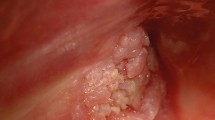Abstract
Scope and purpose This guideline concerns patients with no lesions, innocuous or nonsuspicious lesions, lesions suspected to be potentially malignant as well as malignant lesions of the oral cavity. The audience for this guideline is health care workers who examine the mouth as well as community dental health co-ordinators and policy makers.
Methodology The Appraisal of Guidelines Research & Evaluation reporting checklist II and the GIN-McMaster Guideline Development Checklist were followed and the guideline is partly informed by systematic reviews and diagnostic test accuracy meta-analyses. Studies assessing patients' values and preferences were also considered. The process of moving from the evidence to decisions and the formulation was guided by GRADE (Grading of Recommendations Assessment, Development and Evaluation).
Review and Updating Updates for this guideline will be conducted every five years or when new emerging evidence indicates a potential change in the recommendation statements from the expert panel. Any updated versions of this guideline will be available at the ADA Center for Evidence-Based Dentistry's website: www.ebd.ada
Recommendations The expert panel developed six conditional recommendations, all based on evidence rated as low to very low quality using GRADE.
1. For patients with a clinically evident oral mucosal lesion with an unknown clinical diagnosis considered to be seemingly innocuous or nonsuspicious of malignancy, or other symptoms, clinicians should follow up periodically to determine the need for further evaluation. If the lesion has not resolved and the clinical diagnosis of a potentially malignant disorder cannot be ruled out, then clinicians should perform a biopsy of the lesion or refer the patient to a specialist.
2. For patients with a clinically evident oral mucosal lesion considered to be suspicious of a potentially malignant or malignant disorder, or other symptoms, clinicians should perform a biopsy of the lesion or provide immediate referral to a specialist.
3. Cytologic adjuncts for the evaluation of potentially malignant disorders among adult patients with clinically evident, seemingly innocuous or suspicious lesions are not recommended. Should a patient decline the clinician's recommendation for performing a biopsy of the lesion or referral to a specialist, the clinician can use a cytologic adjunct to provide additional lesion assessment. A positive or atypical cytologic test result reinforces the need for a biopsy or referral.A negative cytologic test result indicates the need for periodic follow-up of the patient. If the clinician detects persistence or progression of the lesion, immediately performing a biopsy of the lesion or referral to a specialist is indicated.
4. The panel does not recommend autofluorescence, tissue reflectance or vital staining adjuncts for the evaluation of potentially malignant disorders among adult patients with clinically evident, seemingly innocuous or suspicious lesions.
5. The panel suggests that for patients with no clinically evident lesions or symptoms, no further action is necessary at that time.
6. The panel does not recommend commercially available salivary adjuncts for the evaluation of potentially malignant disorders among adult patients with or without clinically evident, seemingly innocuous or suspicious lesions and their use should be considered only in the context of research.
Research recommendations There is a need for better estimation of the prevalence of potentially malignant disorders (PMDs) and oral squamous cell carcinoma (OSCC) in populations with different baseline risks. More information on patients' values and preferences is required as well as studies on the diagnostic test accuracy of cytologic and salivary adjuncts.
Similar content being viewed by others
Log in or create a free account to read this content
Gain free access to this article, as well as selected content from this journal and more on nature.com
or
References
Oral Health Foundation. Mouth Cancer Action Month [website] 2018. Available at https://www.dentalhealth.org/Pages/Category/mouth-cancer-action-month?gclid=EAIaIQobChMIudbK2dyT3wIVQeh3Ch1uMg7JEAAYASAAEgKf2PD_BwE (accessed December 2018).
Lewis M [Guest Editor]. Mouth Cancer Special Edition. Br Dent J. 2018; 225.
Conway DI, Purkayastha M, Chestnutt IG. The changing epidemiology of oral cancer: definitions, trends, and risk factors. Br Dent J 2018; 225: 867-873.
Purkayastha M, McMahon AD, Gibson J, Conway DI. Trends of oral cavity, oropharyngeal and laryngeal cancer incidence in Scotland (1975-2012) - A socioeconomic perspective. Oral Oncol 2016; 61: 70-75.
Louie KS, Mehanna H, Sasieni P. Trends in head and neck cancers in England from 1995 to 2011 and projections up to 2025. Oral Oncol 2015; 51: 341-348.
Smittenaar CR, Peterson KA, Stewart K, Moitt N. Cancer incidence and mortality projections in the UK until 2035. Br J Cancer 2016; 115: 1147-1155.
Brocklehurst PR, Speight PM. Screening for mouth cancer: the pros and cons of a national programme. Br Dent J 2018; 225: 815-819.
Purkayastha M, McMahon AD, Gibson J, Conway DI. Is detecting oral cancer in general dental practices a realistic expectation? A population-based study using population linked data in Scotland. Br Dent J 2018; 225: 241-246.
Al Bulushi NM, Macpherson LMD, Worlledge-Andrew H, Gibson J, Ross AJ, Conway DI. A protocol for a systematic review of clinical gudielines and published systematic reviews on the early detection of oral cancer. Translational Research in Oral Oncology 2016; 1: 1-6.
ADA. Center for Evidence-Based Dentistry. Evaluation of Potentially Malignant Disorders in the Oral Cavity Clinical Practice Guideline. Available at https://ebd.ada.org/en/evidence/guidelines/oral-cancer (accessed December 2018).
Kavanagh BP. The GRADE system for rating clinical guidelines. PLoS Med 2009; 6: e1000094
AGREE Enterprise Introduction to AGREE II. Available at https://www.agreetrust.org/about-the-agree-enterprise/introduction-to-agree-ii/
Author information
Authors and Affiliations
Corresponding author
Rights and permissions
About this article
Cite this article
Crossan, L., Conway, D. Another oral cancer clinical guideline - but does it propose changes to dental practice?. Evid Based Dent 20, 7–8 (2019). https://doi.org/10.1038/s41432-019-0005-x
Published:
Issue date:
DOI: https://doi.org/10.1038/s41432-019-0005-x



